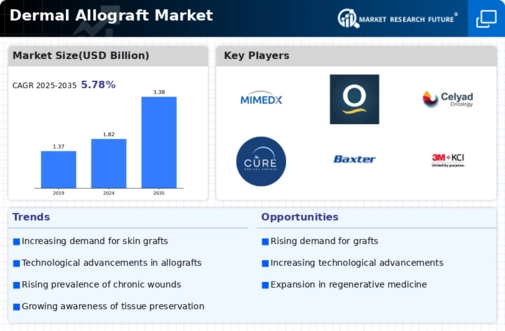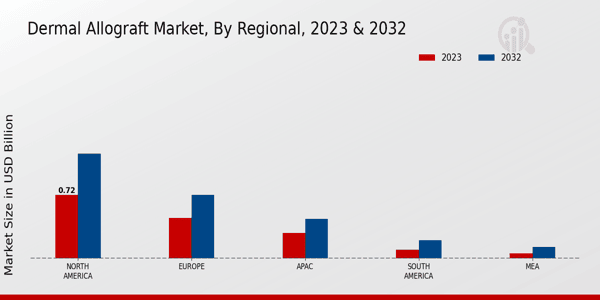Market Growth Projections
The Global Dermal Allograft Market Industry is poised for substantial growth, with projections indicating a market value of 1.82 USD Billion in 2024 and an anticipated increase to 3.38 USD Billion by 2035. This growth trajectory suggests a compound annual growth rate (CAGR) of 5.8% from 2025 to 2035. Factors contributing to this expansion include rising incidences of skin disorders, advancements in surgical techniques, and an increasing geriatric population. The market dynamics indicate a robust demand for dermal allografts, positioning them as a critical component in modern wound care and surgical practices.
Growing Aesthetic Procedures
The rising popularity of aesthetic procedures is a notable driver for the Global Dermal Allograft Market Industry. As consumers become more conscious of their appearance, the demand for cosmetic surgeries and skin rejuvenation treatments has surged. Dermal allografts are increasingly utilized in aesthetic applications, such as facial reconstruction and scar revision, due to their ability to promote natural healing and improve skin texture. This trend is likely to propel the market forward, with a compound annual growth rate (CAGR) of 5.8% anticipated from 2025 to 2035, reflecting the growing intersection of healthcare and aesthetics.
Increasing Geriatric Population
The increasing geriatric population is a significant factor driving the Global Dermal Allograft Market Industry. As individuals age, they become more susceptible to skin-related issues, including chronic wounds and skin tears. The demand for effective wound care solutions is therefore heightened among this demographic. Dermal allografts offer a promising option for treating these conditions, as they support healing and reduce complications. With the global population aged 65 and older projected to reach 1.5 billion by 2050, the market for dermal allografts is expected to expand, addressing the unique healthcare needs of older adults.
Supportive Regulatory Frameworks
Supportive regulatory frameworks play a crucial role in shaping the Global Dermal Allograft Market Industry. Governments and health authorities are increasingly recognizing the therapeutic potential of dermal allografts, leading to streamlined approval processes and enhanced funding for research and development. These supportive measures facilitate the introduction of innovative products into the market, ensuring that patients have access to advanced treatment options. As regulatory bodies continue to promote the use of dermal allografts, the industry is likely to see sustained growth, fostering an environment conducive to innovation and improved patient care.
Rising Incidence of Skin Disorders
The Global Dermal Allograft Market Industry is experiencing growth due to the increasing prevalence of skin disorders such as burns, chronic wounds, and surgical wounds. According to health statistics, the incidence of skin-related conditions is on the rise, leading to a higher demand for effective treatment options. Dermal allografts provide a viable solution for wound healing and skin regeneration, which is crucial for patients suffering from these ailments. As healthcare providers seek innovative methods to address these challenges, the market is projected to reach 1.82 USD Billion in 2024, reflecting a growing recognition of the benefits of dermal allografts.
Advancements in Surgical Techniques
Technological advancements in surgical techniques are significantly influencing the Global Dermal Allograft Market Industry. Innovations such as minimally invasive procedures and enhanced grafting techniques have improved patient outcomes and reduced recovery times. These advancements not only facilitate the effective application of dermal allografts but also encourage their adoption among healthcare professionals. As surgical practices evolve, the demand for dermal allografts is expected to increase, contributing to a projected market value of 3.38 USD Billion by 2035. This growth underscores the importance of integrating cutting-edge technology into wound care and surgical practices.













